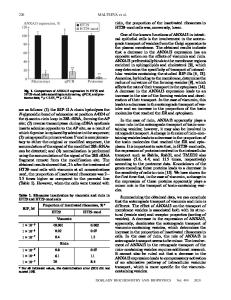Anomalous Diffusion in Active Intracellular Transport
- PDF / 788,233 Bytes
- 12 Pages / 612 x 792 pts (letter) Page_size
- 12 Downloads / 374 Views
Anomalous Diffusion in Active Intracellular Transport Avi Caspi, Rony Granek, Michael Elbaum Department of Materials and Interfaces Weizmann Institute of Science Rehovot 76100, Israel ABSTRACT The dynamic movements of tracer particles have been used to characterize their local environment in dilute networks of microtubules, and within living cells. In the former case, 300 nm diameter beads are fixed to individual microtubules, so that the movements of the bead reveal 3 undulatory modes of the polymer. The mean square displacement shows a scaling of t 4 in keeping with mode analysis arguments. Inside a cell, beads show a more complicated behavior that reflects internal dynamics of the cytoskeleton and associated motors. When placed near the cell edge, 3 micron diameter beads coated by proteins that mediate membrane adhesion are engulfed underneath the membrane and drawn toward the center by a contracting flow of actin. On reaching the region surrounding the nucleus, the beads continue to move but lose directionality, so that they wander within a restricted space. Measurement of the 3 mean square displacement now shows a scaling of t 2 up to times of ~1 sec. At longer times the 1 scaling varies between t1 and t 2 in the various runs. The data do not fit a crossover between ballistic ( t 2 ) and diffusive ( t1 ) behavior. The movement is clearly driven by non-thermal interactions, as it cannot be stopped by an optical trap. Treatment of the cell to depolymerize microtubules restores ordinary diffusion, while actin depolymerization has no effect, indicating that microtubule-based motor proteins are responsible for the motion. Immunofluorescence microscopy shows that the mesh size of the microtubules is smaller than the bead diameter. We propose that the observations are related, and that the non-trivial scaling in the polymer system leads to time-dependent friction in a network, which in turn leads to a generalized Einstein relation operative in the intracellular environment. This results, in the driven system, in sub-ballistic motion at short times and sub-diffusive motion at longer times. INTRODUCTION In a symposium on dynamics in small confining systems, the living animal cell is almost an ideal laboratory. Enveloped by a single lipid bilayer, it contains structural and functional elements in all dimensions: a bulk solvent phase, a distinct liquid phase confined to vesicles and membrane-bound reticuli, numerous two-dimensional internal membranes, an extended network of filaments that collectively make up the cytoskeleton, and isolated molecular machines that function as individual entities. Coordination of the biochemistry involves a complex transport machinery that relies on a balance between thermal diffusion and deliberate delivery. In the latter case an important role is played by mechanoenzymes, commonly called “motor proteins” that carry cargo in one or the other direction along oriented tracks formed by cytoskeletal filaments. This discussion will focus on the special micro-rheological environment formed by su
Data Loading...








